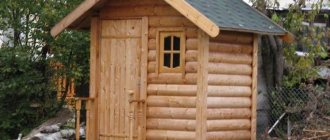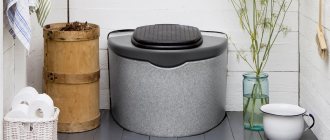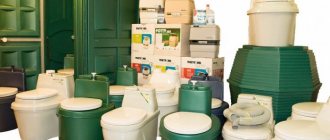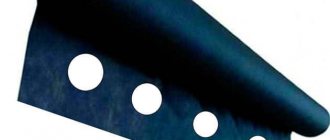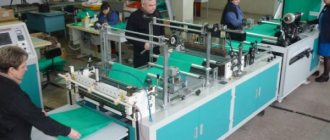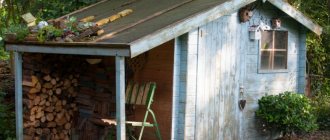Every summer resident wants to provide the most comfortable living conditions on his property. One of the main conditions is the presence of a toilet. Therefore, this structure can be considered the main one and, as a rule, it is built first on an empty garden plot .
The simplest option is a regular pit with a stall installed on top, but such a typical wooden toilet has two significant drawbacks: a strong odor and the need for periodic cleaning of the toilet .
Therefore, today we will try to discuss how to make a toilet for a summer house without smell and pumping out sewage.
Requirements for toilets in the country
In order for the toilet in the country to become not only a beautiful and comfortable place, but also meet the standards and requirements, before installing it, it is necessary to take into account SNiPs and SanPiNs.
The building codes and rules that regulate the requirements for toilets in the country are set out in No. 30-02-97 in two paragraphs:
- Clause 8.7 of SNiP - if there is no central sewerage system, then dry toilets and powder closets can be used in the areas. It is also not prohibited to install cesspools (backlash-closet) and outhouse latrines in the country.
- Clause 8.8 of SNiP - collection and disposal of waste is possible in a drainage trench, no closer than 4 m from the adjacent fence, or, with the permission of the SES, along an organized ditch into an external ditch.
The same SNiP explains the meaning of the terms for various country toilets:
- composting toilet - a system for processing waste through oxidation during heating or chemical treatment into organic fertilizer;
- backlash closet - a toilet with backlash ventilation in the house; feces, when flushed through the pipe, pass into the external cesspool;
- powder-closet - a toilet in a country house, where waste products are treated with peat or powder and stored in bulk form in an insulated box until completely composted;
- an outhouse is a lightweight building above a cesspool.
These standards are the same for dacha plots throughout the country, but each region, due to climatic and topographic features, has its own control system, with which it is necessary to coordinate actions when installing a toilet on the plot.
Attention! When installing a toilet in a country house, you must remember that it is forbidden to install backlash toilets in the 4th climatic and 3rd “B” subdistricts.
In addition to SNiPs, the safety and environmental friendliness of toilets in a dacha are regulated by sanitary rules 42-128-4690-88, for failure to comply with which a dacha resident can be fined up to 5 thousand rubles. The main points outlined in this paragraph are as follows:
- mandatory sealing of the cesspool;
- 3 m – maximum depth of the cesspool;
- contact of the cesspool with groundwater should not be allowed;
- cleaning the cesspool at least once every 6 months (or before reaching 350 mm of filling the container);
- All stages of water purification from septic tanks are mandatory.
Compliance with these requirements will save the owner of a summer cottage from fines and possible unpleasant litigation with neighbors and municipal services.
So how do you install a cabin without a base?
Everything is very simple. To do this, concrete posts for trellises are taken, and a booth is installed on top of them. You can also place the booth on ready-made reinforced concrete monoliths or bricks. But the first option (columns) will be better. In the southern regions, trellis posts are often used for vineyards, and where the climate is not so mild, they are used for climbing plants.
Trellis posts are produced in lengths from 1.2 to 6 meters, with dimensions from 10X12 to 20X30 centimeters. They have a trapezoidal cross-section. On the larger side there are wire rod rigging eyes ranging in size from 6 to 12 millimeters, on the smaller side there are rounded corners. To get the pins on which the booth will be attached to the base, you need to saw the eyes in the middle part with a grinder and straighten them.
If a cesspool is provided for the toilet in advance, then you don’t have to worry about the safety of the rear beam of the cabin, which serves as a support. In this case, the negative chemical environment is not dangerous for the tree.
If your summer cottage is located in an area where there are frequent winds, then the cabin still needs to be strengthened. Profiled pipes (40x40x2) or support posts made of timber (80x80) are well suited for this. In this case, the metal base needs to be concreted about half a meter below the humus layer, and the wooden base must first be treated with hot bitumen, then with rough roofing felt with sprinkling, and then dug to a depth of 30 centimeters.
Options for toilets in the country
Having dealt with the permitting requirements for a latrine on a site, you can determine which type of comfortable toilet in a dacha best meets the requirements and wishes of the site owner.
The choice of toilet is determined by the frequency of visits to the country estate and the number of people who will use it. Depending on the type of device, a toilet for a summer house can be located not only on the street, but also in the summer resident’s premises. Each of the toilet options has its own advantages and nuances, which you should familiarize yourself with before making your final choice.
Outdoor types of toilets for summer cottages
One of the most common types of toilets in the countryside is still an ordinary lightweight separate outdoor house.
Such birdhouse toilets in the country are convenient because they are located at a distance from the home and do not bother people with the unpleasant smell of waste.
Simple designs are economical; often when arranging them, a summer resident makes do with available materials or minimal investments. Installation and installation of a lightweight outdoor toilet in a country house is quite simple. You can choose a booth of any shape as the upper part of the structure.
Many carpentry shops and gardening stores offer free access to toilet options for summer cottages, from simple wooden ones to beautiful carved houses.
Various resources are used as material for arranging an outdoor toilet at the request of the owner of the site.
Depending on the type of waste accumulation, outdoor toilets in the country can be with or without a cesspool (powder-closet).
Outdoor toilet with cesspool
In addition to the above-ground part of the toilet in a country house with a cesspool, the hidden from view but important underground part of the outhouse is also carefully thought out. The cesspool must meet sanitary requirements. To do this, various methods of hermetically arranging it are used to prevent the spread of helminths and contamination of the soil:
- rubber tires or concrete rings;
- solid cement or brick tank;
- plastic container.
As the cesspool is filled with waste, it is cleaned using a sewer truck, which should be able to drive up and extend a hose to the toilet in the country.
To ensure that unpleasant odors escape from the outdoor toilet stall and are not absorbed into the walls of the house, a hole is provided above head level or a simple ventilation pipe is installed.
This type of outdoor birdhouse-toilet in a country house is suitable for any number of people and only requires pumping out waste as the cesspool fills.
Street powder closet in the country
In terms of external features, there is practically no difference between a street toilet with a cesspool and a powder closet. The difference between these types of latrines is the method of collecting feces. The powder closet does not have a large hole under the house and, as a result, there is no need to call a sewer truck to pump out sewage. Instead of a large cesspool, a compact container is installed, which, as it is filled, is emptied into a compost pit at the dacha. This becomes possible by sprinkling the waste with peat, sawdust or powder after each visit to the house. To do this, the cabin of an outdoor powder closet must be equipped with a sealed tank for collecting feces and a container with peat or small sawdust.
A tank for collecting feces is installed under the toilet seat; its volume, as a rule, does not exceed 10-15 liters. It is easy for one person to take such a container to the compost pit as it is filled. A container with peat or sawdust is placed in the toilet stall so that after defecation, waste can be sprinkled with its contents through the hole in the toilet seat.
Thus, each time the waste is powdered with sawdust or a peat mixture, which reduces the foul odor, and most importantly, helps turn feces into compost. This device allows the use of feces powdered with peat after complete composting as a feed for plants in the country due to the fact that decomposition occurs without chemical exposure. In order for the fecal-peat mixture to quickly become suitable for fertilizer after being thrown into a compost pit, summer residents often use additional preparations.
Advice! The drug "Biocompostin" reduces the natural formation of compost in the general heap from 3 to 1 year.
In the house, in addition to tanks for waste and powder, a ventilation pipe and a door for removing the tank are formed, if the plane of the toilet seat is built into the overall structure of the house.
An outdoor powder closet, like a budget cesspool, is easy to install, but is not designed for a large number of people in the country due to the small storage tank and the long period of waste decomposition.
Home types of toilets for the garden
There are types of country toilets, the design and waste collection of which allows them to be placed in a residential building. This allows you to relieve yourself without leaving your home, even if there is no central sewage system at your dacha.
Dry toilet
A dry toilet involves the complete recycling of waste by exposing it to chemicals or electricity. The operating principle of a chemical dry toilet is simple. The upper reservoir contains water, which, when flushed with waste along with feces, enters the lower storage tank, interacting with chemicals until the waste products are completely decomposed.
There is a valve in the lower container that retains unpleasant odors and prevents them from spreading into the toilet. When the tank with processed waste is full, it is disconnected from the general structure and taken out to dispose of the final residues. After emptying the lower container, it is washed and chemicals are added.
When pouring chemicals, different types of substances are used:
- Formaldehyde is the most effective and fast-acting preparation. The high toxicity of chemicals forces the final disposal of residues to be carried out away from plantings, and best of all into the central sewer system.
- Ammonium - break down waste in 5-7 days, working without access of oxygen to the container. A more gentle way of breaking down waste, which allows its reuse in the compost pit of the dacha.
- Biological - a selected composition of living bacteria that turns feces in the receiver into fertilizer. The drugs are absolutely safe for humans and the environment, but are expensive.
Many modern models of chemical portable toilets have a tank full sensor, which indicates that it is time to empty the tank.
This type of toilet in a country house is convenient if it is used by a small number of people. As a rule, if the device is visited by only one person, then it will have to be emptied no more than twice a month. If a family of 2-3 people uses the toilet - once a week, or even more often.
Electric dry toilets in the country look like a regular toilet. They are installed next to the outlet for connecting the ventilation system and compressor.
The electricity consumption of such a device is small - it is equivalent to the operation of a regular light bulb.
The operating principle of an electric dry closet in a country house comes down to separating waste into liquid and solid. Liquid waste, passing through the hose, enters the prepared drainage, and solid waste is dried by a compressor to a powder state. They are dried until flour is concentrated in a special toilet tank, then they can be used to fertilize plants in the country.
Despite the compactness and aesthetic appearance of the electric toilet in the country, it has a number of disadvantages that must be taken into account before installation:
- connection to the presence of light in the country - if the electricity is turned off, the toilet stops working;
- the need to arrange a drainage tank on the street;
- high cost of the main unit.
Backlash closet
The construction of a backlash closet at the dacha consists of two parts: the toilet seat is located indoors, and the feces collection is located outdoors.
This is an improved design of an outdoor cesspool toilet-birdhouse and a toilet in a home-type toilet. A backlash closet can look like a familiar city toilet - a flush toilet, a washbasin.
The arrangement and decoration of the toilet room does not require any special requirements, with the exception of good ventilation of the room. To do this, it is advisable to install, in addition to the room window, a forced system based on an exhaust propeller.
The entire main sewer system is underground.
A pipe 60-70 cm long and at least 110-150 cm in diameter is installed from the toilet into the external cesspool. It should not rest against the bottom of the cesspool and be strictly vertical to prevent clogging and stagnation of feces in the toilet. The cesspool itself extends 0.8 -1 m under the toilet room and in this place is about a meter deep.
The main volume of the tank, which is located underground next to the house, is determined based on the number of people. The calculation is made as follows: about 1 square meter is allocated for one regular visitor to the dacha. m. Near the cesspool area under the toilet itself, a slope is made away from the toilet, reaching a depth of 2 m. Along the perimeter, the dimensions of the main pit are approximately 3 by 3 m.
Be sure to provide a hatch through which sewage is pumped out using a sewage machine. The toilet tank is cleaned when the level does not reach the top by 50 cm.
To prevent gases from accumulating in an underground reservoir, when building such a toilet in a country house, an exhaust hood is made - a backlash channel from the cesspool to the street. An exhaust pipe is installed at a distance of 30 cm from the ceiling, through which air from the cesspool flows outside. As a rule, for the backlash channel they use a pipe with a diameter of 150 by 150 mm and lead it half a meter above the smoke channel, covering it with a weather vane on top.
Important! All backlash channel connections must be sealed.
Structures, cladding and materials
As a rule, 4 types of lumber are used for the cabin. This:
- edged and unedged boards (“twenty”) or roof slats measuring 50x20;
- for cladding on the outside - edged or tongue-and-groove boards with dimensions from 20 to 30 millimeters;
- for the flooring and toilet seat - tongue and groove boards (40X (120-150));
- frame beam (80x80 or 60x60).
You can replace the sheathing board with OSB (8X20 thick) or waterproof plywood. By the way, you can cut laths from OSB for sheathing. A little more expensive, but in some respects even better, is a tongue-and-groove for sheathing.
The best option for covering the cabin with tongue-and-groove boards is horizontal cladding with belts. In this case, the ridges of the tongues should be directed upwards, and the grooves downwards, which will protect the sheathing from the accumulation of unnecessary moisture in the tongues. The door is sheathed vertically.
Boat planking. Photo:
If the design plan includes curved sections, then it is best to cladding it with boat boards according to the marine type, as shown in the figure. This will be especially good for areas where there is a lot of rainfall, but a little worse for windy areas where tongue and groove piling is best. Using an electric jigsaw with a rotary shoe, you can make a cut edge from a boat board. In this case, it is important to observe the angle of inclination of the visor of the board, which should be within 30 degrees. It should also be taken into account that the canopies of the boards should be directed downward along the slope, as shown in the figure.
It is important to know that after pruning, solid lumber must be treated with special preparations that prevent putrefactive processes - biocides. Afterwards, it is necessary to impregnate it twice with a water-polymer emulsion. This product is affordable and can provide good protection against dampness for many years. You should definitely adhere to a strict impregnation sequence. Otherwise, PVA glue simply will not allow the biocide to cover the wood with a protective film. It is better to treat materials for covering the toilet seat and flooring (from the inside), which face the cesspool or the ground, with bitumen mastic or hot bitumen.
